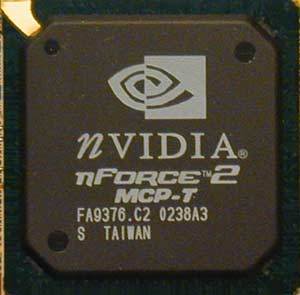Athlon On The Fast Lane: Three Motherboards with nForce2-Chipset and Dual-Channel DDR
nForce2: Features
The MCP-T is one of two south bridge chips. It supports UltraATA/ 133, six USB 2.0 ports, dual network controllers, hardware sound processing and IEEE1394 Firewire. The standard version (non-T) lacks the last three features.
I don't want to spend too many words on the details of the nForce2 chipset, as there is already an excellent article that deals with the architectural details of nForce2: Full Power: NVIDIA Attacks With nForce2 .
Rather, I'd like to summon up the main differences in comparison to the competitors from VIA (KT400) and SiS (SiS746). All of today's chipsets support both DDR266 and DDR333. DDR400 is no longer supported by the chipset manufacturers due to the lack of performance: DDR333 at CL2 is at least equally fast or even faster. nVIDIA still supports DDR400, as there are some (few!) applications that still benefit from the higher clock speed - in defiance of overhead.
USB 2.0 has become standard today, so it's no surprise that it is supported by SiS (SiS963), VIA (VT8235) and nVIDIA (MCP/MCP-T) south bridges. In addition, nVIDIA's MCP-T also comes with an integrated IEEE1394/ Firewire controller, which can be activated by only a little codec. You may already know this approach from your sound system.
"Sound" is a very hot topic with nForce2. Again, the MCP-T is the better south bridge if you are interested in nVIDIA's APU (Audio Processing Unit ). Thanks to several signal processor levels, the APU features audio acceleration and is able to play back an MP3 file with only a minimum CPU usage.
Already introduced and supported by both VIA and SiS as well as nVIDIA is AGP 3.0 (AGP 8x ). This latest standard allows graphics data to be swapped to the main memory rather than the local memory, now at 2.1 GB/s. A fact that seems rather unimportant today, as local frame buffers work at up to 20 GB/s (Radeon 9700 Pro), and are growing in size as well.
I have already been talking about performance, so here we go again: nForce2 is one of the first chipsets that officially supports 166/ 333 MHz FSB for the latest Athlons. VIA's KT400 does it, too. So far, SiS has not changed the specifications for the SiS746 chipset, leaving it unsuitable for Athlon XP 2700+ and 2800+.
Get Tom's Hardware's best news and in-depth reviews, straight to your inbox.
Last but not least, there is the "main feature" of nForce2, its dual-channel memory interface . In contrast to VIA and SiS, nVIDIA is able to bundle two DIMMs in order to double the bandwidth.
Current page: nForce2: Features
Prev Page Power To The Athlon! nForce2 Chipset Motherboards Next Page nForce2 Vs. nForce2 "Light"
Patrick Schmid was the editor-in-chief for Tom's Hardware from 2005 to 2006. He wrote numerous articles on a wide range of hardware topics, including storage, CPUs, and system builds.
